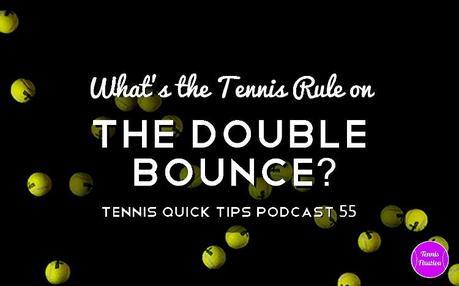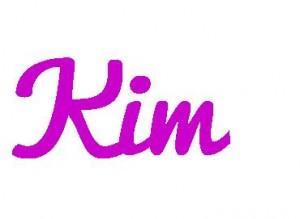Podcast: Play in new window | Download
Once again, we’re going to talk about tennis rules. You know I truly love tennis rules. Because just when you think you know them, something in a match happens that makes you think you don’t. In this week’s episode, we’re talking about the rule on double bounces, or when the ball is “not up.” By the end of this episode, you’ll know what the rule on this is, who makes the double bounce call, and just what a “not up” ball is. You can listen to this episode by clicking on the media player above or by listening in with your favorite podcast app. You can also subscribe in iTunes by clicking on this link: tennisfixation.com/itunes.

SHOW NOTES:
During a recent doubles match I played, a dispute arose over the dreaded double bounce – did it or didn’t it bounce twice before it was hit?
So here’s the set-up:
- My partner served.
- Our opponent returned to my partner.
- My partner hit the ball back.
- Our opponent, moving into the net, again hit the ball to my partner.
- My partner returned the ball but, at the same time, she said, “That was a double bounce. The ball double bounced.”
- Our opponent again hit the ball, this time hitting it out. Then she said, “It wasn’t a double bounce and that’s my call to make anyway. I make that call. But we lost the point anyway.”
- My partner then said, “No, no. You’re right. It’s your call. Let’s play the point over.”
So now we’re all standing around trying to figure out what just happened and what should happen next. Or maybe it was just me that was trying to figure out what should happen next.
What’s the tennis rule on “double bounces”?
Well, as I always say, let’s look at the rules! Rule 24.b. of the ITF Rules of Tennis says that a player loses the point if “The player does not return the ball in play before it bounces twice consecutively . . . .” So, in our match, if the ball bounced twice before my opponent returned it, she lost the point.
What’s a “not up” ball?
And I’m going to throw in a little bonus lesson for you here – a ball that double bounces is also said to be “not up.” This is a phrase that no one uses here, where I play tennis, but you might hear it in your area or when you watch the pros play on TV. So if a player hits a ball after a double bounce, you would say he played the ball when it was “not up” and the player would lose the point.
Who makes the double bounce call?
So back to the rules on double bounces? The question that usually comes up in these situations is not just whether a double bounce occurred, but who gets to make the call as to whether it occurred. If you’re playing in an officiated match, obviously the official would make that call. But, as most of us are playing in unofficiated matches without the luxury of a tennis official, we have to look to The Code.
The Code says, in Paragraph 5, that “A player calls all shots landing on, or aimed at, the player’s side of the net.” Now, that’s an important provision to remember in any situation because it usually tells you who gets to call what.
In this double bounce situation, The Code makes very clear, in Paragraph 19, that, “A player shall concede the points when: A ball bounces more than once in that player’s court.” So, in my match, it was, our opponent’s prerogative to make the double bounce call and, when she said the ball didn’t double bounce, we had to accept that.
Got it? You lose the point if it double bounces before you return it. But the double bounce call is yours to make.
Wasn’t there a hindrance?
Now here’s the little twist to the situation that happened in my match. The Code says, in Paragraph 33, that “A player who claims a hindrance must stop play as soon as possible.” The Code goes on to say, in Paragraph 34, that “When talking interferes with an opponent’s ability to play a ball, it is a hindrance.” So what I thought was going to happen during our match was that our opponent was going to claim that my partner’s talking during the point, when my partner said, “That was a double bounce. The ball double bounced”, hindered my opponent’s ability to play the point and therefore we would have lost the point. And I think she could rightly have said that. But she would have had to stop play at that point, which she didn’t do. She continued playing and hit the ball out, making the whole double bounce thing moot in my opinion! So she was actually right when she said, “But we lost the point anyway.”
So what happened in my tennis match?
Well, you’re probably wondering what actually happened in my match? My partner is very, very nice and I know she felt bad for talking during the point so she offered to replay the point. I wasn’t going to argue about that with my partner so that’s what we did, even though I’m sure that point was ours. And we ended up winning that point anyway so it’s all good!
The big takeaway here is to remember that the double bounce is called by the person hitting the ball. It’s a hard call to make sometimes but, if you’re on the other side of the net, you just have to have faith that the vast majority of people are going to honestly make the call the best they can.
RESOURCES AND LINKS:
If you’re really interested in the tennis rules and want to know how they apply in the most common situations you see on court, check out these Tennis Quick Tips episodes:
- Best Practices for Using Notes on the Tennis Court – TQT Episode 51
- How Much Time Is Too Much Time on the Tennis Court? – TQT Episode 49
- What’s the Rule on Hindrances? TQT Episode 39
- What’s the Rule on Reaching Over the Net? – TQT Episode 36
- Using an On-Court “Cheat Sheet” – TQT Episode 29
SHARE THIS EPISODE:
If you enjoyed this episode, or know someone who might, please feel free to share it with them. You can simply direct people to:
- http://TennisFixation.com/quicktips55
There are also sharing and email buttons at the bottom of this post.
PLEASE SUBSCRIBE AND REVIEW:
Be sure and subscribe to Tennis Quick Tips so you never miss an episode:
- iTunes: Visit the Tennis Quick Tips iTunes page and subscribe (click on the “Subscribe” button or the blue “View in iTunes” button) or search for “Tennis Quick Tips” in the iPhone Podcast app.
- Stitcher: Visit the Tennis Quick Tips Stitcher page and subscribe.
- RSS Feed: Go to the Tennis Quick Tips Podcast RSS feed to listen in.
- Podcast Page: Find every episode of Tennis Quick Tips in one easy-to-navigate place by visiting the Tennis Quick Tips Podcast page.
I hope you’ll consider leaving your review and rating on iTunes by clicking here. It will help the show become more easily discovered by like-minded, awesome people just like you. I really appreciate it!
Thanks so much for listening and, as always, Happy Tennis!

© Kim Selzman 2014 All Rights Reserved

